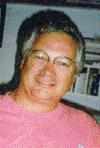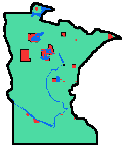Federally recognized
Beltrami, Cass, Hubbard and Itasca counties, Minnesota
Rt 3, Box 100, Cass Lake, MN 56633
(218) 335-8200
Leech Lake Band of Ojibwe
Leech Lake Tribal College
Total area 602,889 acres;
Tribally owned: 21,507acres
Allotted (members): 12,639 acres
State trust: 30,000 acres
Other: 507,750 acres
Total labor force: 1069
Total enrollment: 7173
Total reservation population: 3725
Highschool graduate or higher: 60.2%
Per capita income: $4705
Total unemployment: 30.9%
The BIA has an area field agency office for all the northern Minnesota reservatins at Cass Lake (part of the Leech Lake reservation). Administration and forestry offices are located there. Contact:
U.S. Dept of the Interior
Bureau of Indian Affairs
Minnesota Agency
Rt 3 Box 112
Cass Lake MN 56633
FAX (218) 335-2819
Contact: Raymond C. Laitala, Forester (218) 335-2811
Leech Lake-Cass Lake reservation was established by the Treaties of February 22, 1855 and May 1, 1867, and by Executive Orders of October 28, 1873 and May 26, 1874. Original boundaries contained 677,099 acres. Because of allottment, tax forfeitures, and seizures for federal, state, and county local governments forest and park lands, only slightly over 5% of the land remains in Indian hands and control at poresent, for housing in scattered communities. The bulk of the reservation land is now Chippewa National Forest, which attracts about 1.5 million tourists a year. The famed headwaters (starting point) of the Mississippi River lie in Itasca State Park, within the reservation boundary, but not now Indian land.
Desireable shoreland sites on the many beautiful lakes are owned and operated by non-Indian resort owners for the most part. There is and for many years has been a large sport-fishing industry on the 232 Lakes and 68 miles of the northernmost Mississippi. Sport fishing provides jobs to an estimated 600 people, which includes only 2 Indians, both employed by the tribal fishery enterprise. Because of the sport-fishing tourist industry, retail business on reservation lands -- that is, lands within the legal boundary -- generates $570 million annually, and provides 8450 jobs. Almost none of this is Indian. The Tribal Council has a number of business development plans and attempts to encourage and subsidize Indian small business startups. The tribe owns the Oningum Marina and the Che-Wa-E-Gon gift-store and restaurant.
The most harmful U.S. governmental actions to land holdings were the Dawes General Allotment Act (1887), which over all of Indian country cost Indian nations hundreds of millions of acres in very few years, and the Nelson Act of lookupyear, which ordered all Ojibwe people of Minnesota to move to the White Earth Reservation and provided for the taking of all remaining lands outside its then-boundaries. The Indian forest was entirely logged over by railboard and timber combines of the early 20th century; forest lands in all of this area are now regrowth, not original. Of the lands still in Indian formal, legal ownership, about 10,000 acres is in farmland, small family farms -- truck garden plots and very small dairy farms. There are about 20,000 acres of tribal forest lands (500,000 acres of the reservation's forest land is considered "public" i.e. non-Indian). Sustained-yield forestry harvest on the 20,000 acres of tribal forest land is being investigated.
  Leech Lake Band operates 2 casinos: the Northern Lights Gaming Emporium, just south of a fair-sized mostly-white town, Walker, and the Leech Lake Bingo and Palace Casino located at Cass Lake, the long-time BIA Agency town in the northwestern corner of the reservation. You can see an uninformative slow-loading ad for the Palace Casino on the poorly-designed web brochure for all Minnesota tribal casinos, on the Minnesota Gaming Association server Leech Lake Band operates 2 casinos: the Northern Lights Gaming Emporium, just south of a fair-sized mostly-white town, Walker, and the Leech Lake Bingo and Palace Casino located at Cass Lake, the long-time BIA Agency town in the northwestern corner of the reservation. You can see an uninformative slow-loading ad for the Palace Casino on the poorly-designed web brochure for all Minnesota tribal casinos, on the Minnesota Gaming Association server
These facilities employ approximately 500 people (some of them Indian) and provide a most important tribal revenue source. The tribal government itself employs 524 people in direct service positions, and an unknown additional number of tribal members are employed by the federal agencies headquartered at Cass Lake, and the several federal (BIA) schools in various reservation Indian communities such as Pine Point. Many reservation contractors work in housing, commercial and retail construction. The tribe also owns the LL Construction Building, on 4.3 acres. There are a few manufacturing concerns on the reservation, including a small electronics parts comapny, and some small, private sawmills. Most of the larger wood-based manufacturing concerns of the area are owned by non-Indians, but occasionally employ some Indian people.
 Leech Lake is also involved -- through one of its people now living in Oregon -- in an international form of Web marketing of Leech Lake products, notably wild rice in birchbark trays and baskets made by local craftspeople. Jim Foster, now of Portland, Oregon, started his food service enterprises there some years ago, and now holds school lunch contracts for several schools, as well as providing the delicious (and expensive) gift baskets. See his products, a bio note, and a delicious wild rice salad recipe on his page at ONABEN, a Native enterprises support organization for Northwest Coast tribal people. Jim's food arrays also involve Siltez salmon, product of that Oregon tribe's traditional fish smokehouse operation. His activities are an inspiration to young people (and it certainly made me hungry, when I found his pages, browsing the web early this morning)! What a nice gift, for those who can afford it! Leech Lake is also involved -- through one of its people now living in Oregon -- in an international form of Web marketing of Leech Lake products, notably wild rice in birchbark trays and baskets made by local craftspeople. Jim Foster, now of Portland, Oregon, started his food service enterprises there some years ago, and now holds school lunch contracts for several schools, as well as providing the delicious (and expensive) gift baskets. See his products, a bio note, and a delicious wild rice salad recipe on his page at ONABEN, a Native enterprises support organization for Northwest Coast tribal people. Jim's food arrays also involve Siltez salmon, product of that Oregon tribe's traditional fish smokehouse operation. His activities are an inspiration to young people (and it certainly made me hungry, when I found his pages, browsing the web early this morning)! What a nice gift, for those who can afford it!
Four municipal tribal community centers and 11 other tribal centers cover scattered communities which (by roads) are widely separated by the large and small lakes within the reservation. The tribe's Bug-o-Nay-Ge-Shig K-12 school offers many excellent programs, and was originally started as an American Indian Movement (AIM) Survival School, named after the famed 19th century Anishinabe leader Hole in the Day (Bugonaygeeshig). This school recently notified me they have a web page now; it will be linked here and on the Native SCHOOLS page as soon as they tell me the URL, which they forgot to mention.
Bug-O-Nay-Geeshig, II was a famous chieftain son of a famous father-warrior. Here is a short biographical sketch of his life, by Minnesota Wahpetonwan Dakota Charles A. Eastman (Ohiyesa), written in 1916. The name is so highly regarded among Minnesota Ojibwe people that it now serves as a title -- elders get together and decide who should carry this name. It is presently held by a man who leads the Sandy Lake Band.
|


 Leech Lake Band operates 2 casinos: the Northern Lights Gaming Emporium, just south of a fair-sized mostly-white town, Walker, and the Leech Lake Bingo and Palace Casino located at Cass Lake, the long-time BIA Agency town in the northwestern corner of the reservation. You can see an uninformative
Leech Lake Band operates 2 casinos: the Northern Lights Gaming Emporium, just south of a fair-sized mostly-white town, Walker, and the Leech Lake Bingo and Palace Casino located at Cass Lake, the long-time BIA Agency town in the northwestern corner of the reservation. You can see an uninformative  Leech Lake is also involved -- through one of its people now living in Oregon -- in an international form of Web marketing of Leech Lake products, notably wild rice in birchbark trays and baskets made by local craftspeople. Jim Foster, now of Portland, Oregon, started his food service enterprises there some years ago, and now holds school lunch contracts for several schools, as well as providing the delicious (and expensive) gift baskets.
Leech Lake is also involved -- through one of its people now living in Oregon -- in an international form of Web marketing of Leech Lake products, notably wild rice in birchbark trays and baskets made by local craftspeople. Jim Foster, now of Portland, Oregon, started his food service enterprises there some years ago, and now holds school lunch contracts for several schools, as well as providing the delicious (and expensive) gift baskets.